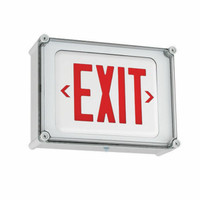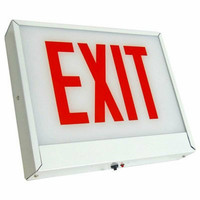-

Barron Lighting Group
Barron Lighting Group 403EX-LB-BB-220V-TRH 400EX Series Die-cast Exit Sign
Call for PriceView Details -

Barron Lighting Group
Barron Lighting Group 403EX-LB-BB-TRH 400EX Series Die-cast Exit Sign
Call for PriceView Details -

Barron Lighting Group
Barron Lighting Group 403EX-LB-BL 400EX Series Die-cast Exit Sign
Call for PriceView Details -

Barron Lighting Group
Barron Lighting Group 403EX-LB-BL-220V 400EX Series Die-cast Exit Sign
Call for PriceView Details -

Barron Lighting Group
Barron Lighting Group 403EX-LB-BL-220V-TRH 400EX Series Die-cast Exit Sign
Call for PriceView Details -

Barron Lighting Group
Barron Lighting Group 403EX-LB-BL-TRH 400EX Series Die-cast Exit Sign
Call for PriceView Details -

Barron Lighting Group
Barron Lighting Group 403EX-LB-WW 400EX Series Die-cast Exit Sign
Call for PriceView Details -

Barron Lighting Group
Barron Lighting Group 403EX-LB-WW-220V 400EX Series Die-cast Exit Sign
Call for PriceView Details -

Barron Lighting Group
Barron Lighting Group 403EX-LB-WW-220V-TRH 400EX Series Die-cast Exit Sign
Call for PriceView Details -

Barron Lighting Group
Barron Lighting Group 403EX-LB-WW-TRH 400EX Series Die-cast Exit Sign
Call for PriceView Details -

Barron Lighting Group
Barron Lighting Group 403EX-WB-BA 400EX Series Die-cast Exit Sign
Call for PriceView Details -

Barron Lighting Group
Barron Lighting Group 403EX-WB-BA-220V 400EX Series Die-cast Exit Sign
Call for PriceView Details

Exit Signs
In the labyrinth of safety and compliance within public and private buildings, exit signs emerge as a critical component of emergency preparedness and regulatory adherence. These illuminated markers guide occupants to safety during emergencies, highlighting the importance of visibility, reliability, and compliance. This article delves into the world of exit signage, exploring the various types, mounting styles, and compliance requirements in jurisdictions such as California, Chicago, and New York. It further examines the indispensable role of exit signs in locations like schools, hospitals, and office buildings across diverse industries.
The Importance of Exit Signage
Exit signs are more than mere fixtures; they are vital safety tools that ensure a swift, orderly evacuation in emergencies. The illumination provided by these signs is crucial in smoke-filled environments or power outages, guiding individuals to the nearest exit. The design and functionality of exit signs, including backlit exit signs and emergency exit signs, are governed by strict regulations to ensure maximum visibility and durability.
Compliance Across Jurisdictions
Compliance with local and federal regulations is paramount in the installation of exit signs. Jurisdictions like California, Chicago, and New York have specific requirements that may exceed national standards.
California: Known for its stringent energy and safety regulations, California mandates exit signs that are highly energy-efficient and visible from a distance, often requiring dual-language signage in specific locations.
Chicago: Chicago's regulations include requirements for exit signs to be durable and tamper-resistant, with the ability to function in extreme conditions.
New York: New York emphasizes the visibility and reliability of exit signage, with mandates for both photoluminescent and electrically powered signs in certain buildings.
Types of Exit Signs
Backlit Exit Sign: These signs use an internal light source to illuminate the sign face, ensuring clear visibility in dark conditions.
Emergency Exit Sign: Equipped with backup power sources, such as batteries, emergency exit signs remain illuminated during power outages, guiding occupants to safety.
Photoluminescent Exit Signs: Absorbing and storing light from the surrounding environment, these signs glow in the dark, offering a reliable, energy-efficient solution without the need for electrical power.
Mounting Styles
The mounting of exit signs is crucial for visibility and compliance. Common styles include:
Ceiling Mount: Ideal for corridors and spaces with limited wall space, providing high visibility from multiple angles.
Wall Mount: Used where direct visibility from the approach path is clear, wall-mounted signs are versatile and easy to install.
Edge Mount: Also known as flag mount, this style projects from the wall, making it visible from both directions in a hallway.
Locations and Industries
Exit signs are ubiquitous in public and private buildings, ensuring the safety of occupants across various settings:
Educational: Schools and universities must have clearly marked exit routes to safeguard students, staff, and visitors during emergencies.
Medical: Hospitals and clinics, with their complex layouts and high occupancy, rely on exit signage to facilitate quick evacuations.
Governmental: Government buildings are required to adhere to the highest standards of safety, with exit signs prominently displayed to ensure public safety.
Commercial and Industrial: From office buildings to manufacturing plants, exit signs are critical in guiding employees and customers to safety in an emergency.
Residential: High-rise residential buildings and complexes also require exit signs in common areas and stairwells to comply with safety codes.
The Role of Exit Signs in Safety and Compliance
Exit signage plays a pivotal role in building safety, offering guidance during evacuations and ensuring compliance with local and national safety codes. The choice between backlit exit signs, emergency exit signs, and photoluminescent signs depends on specific needs, regulatory requirements, and environmental considerations. Proper placement and mounting are equally important to ensure that these signs fulfill their role as critical safety features.
Conclusion
Exit signs are an essential element of safety and compliance in buildings across the globe. From the stringent requirements of California, Chicago, and New York to the diverse applications in educational, medical, governmental, commercial, industrial, and residential settings, exit signage ensures that safety is never left to chance. Whether through backlit, emergency, or photoluminescent signs, the clear, visible guidance provided by these fixtures is indispensable in safeguarding lives during emergencies. As technology and regulations evolve, the importance of exit signs remains constant, embodying the commitment to safety and preparedness in our communities.













